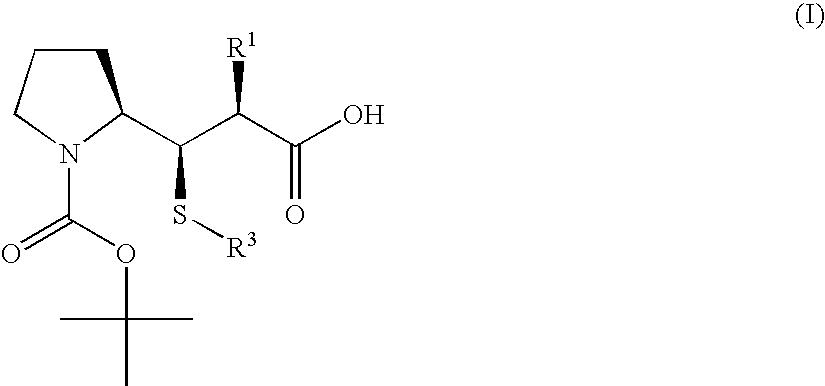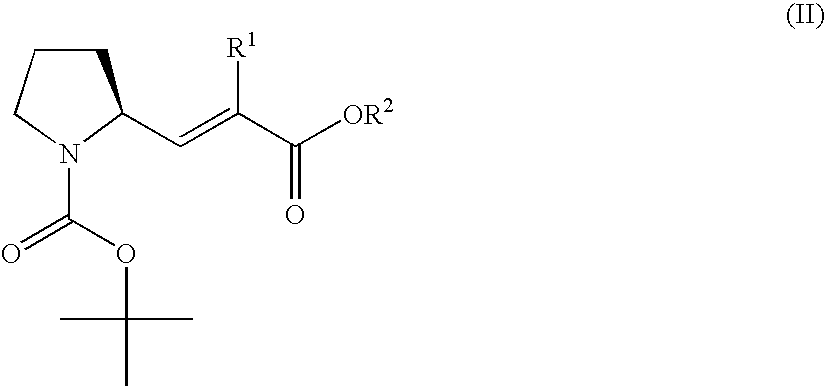3-Pyrrolidin-2-yl-propionic acid derivatives
a technology of 3pyrrolidin and propionic acid, which is applied in the field of manufacturing derivatives of 3pyrrolidin2ylpropionic acid, can solve the problems of low yield and disclosure of synthesis, and achieve the effects of improving the yield of formula compounds, avoiding the laborious separation of diastereoisomer mixtures, and improving the diastereoisomer ratio
- Summary
- Abstract
- Description
- Claims
- Application Information
AI Technical Summary
Benefits of technology
Problems solved by technology
Method used
Image
Examples
example 1
Synthesis of (S)-2-(2-Benzyloxycarbonyl-propenyl)-pyrrolidine-1-carboxylic acid tert-butyl ester (2) (Synthesis with Preformed Wittig Ylide)
[0130]
[0131] a) The Wittig ylide (benzyl 2-(triphenylphosphoranylidene)propionate) can be obtained according to the synthesis disclosed in “Y. Ito, M. Okano, R. Oda, Tetrahedron, 23, 1967, 2137”.
[0132] b) To a solution of 135.7 g benzyl 2-(triphenylphosphoranylidene)propionate (320 mmol) in 440 ml tert-butyl methyl ether was added at rt a solution of 45.5 g Boc-L-prolinal (228.4 mmol) in 62 ml tert-butyl methyl ether. The yellow solution was heated under reflux for 1.5 h upon which a white precipitate of triphenylphosphine oxide formed. From the suspension 230 ml of tert-butyl methyl ether solvent were removed by distillation using a Dean-Stark trap (a water separator used in chemical reactions). Then 360 ml heptane were added drop by drop at reflux temperature to further promote the triphenylphosphine oxide precipitation. The suspension was c...
example 2
Synthesis of (S)-2-(2-Benzyloxycarbonyl-propenyl)-pyrrolidine-1-carboxylic acid tert-butyl ester (2); (Synthesis with in situ Formation of Wittig Ylide)
[0134]
[0135] A solution of 378 g (1-benzyloxycarbonyl-ethyl)-triphenylphosphonium bromide (82.9%, 619.9 mmol) in 1.45 l dichloromethane was azeotropically distilled while keeping the volume constant by addition of 1.20 l dichloromethane. To the solution was added slowly at an internal temperature of 10-12.5° C. a solution of 71.0 g potassium tert-butoxide (98%, 620 mmol) in 640 ml tetrahydrofuran. The yellowish turbid solution was allowed to attain rt and stirred at rt for 75 min. Then, a solution of 127.4 g Boc-L-prolinal (97%, 620.3 mmol) in 640 ml tetrahydrofuran was added, whereby the reaction temperature rose to 25° C. The yellow solution was heated under reflux for 18 h upon which a white precipitate of triphenylphosphine oxide formed. The tetrahydrofuran / dichloromethane solvent mixture was exchanged for 3.6 l heptane. The sus...
example 3
Synthesis of (S)-2-((1R,2S)-2-Benzyloxycarbonyl-1-methylsulfanyl-propyl)-pyrrolidine-1-carboxylic acid tert-butyl ester (3a) in mixture with (S)-2-((1R,2R)-2-Benzyloxycarbonyl-1-methylsulfanyl-propyl)-pyrrolidine-1-carboxylic acid tert-butyl ester (3b) and two further diastereoisomers of (S)-2-(2-Benzyloxycarbonyl-1-methylsulfanyl-propyl)-pyrrolidine-1-carboxylic acid tert-butyl ester of partially undetermined configuration (3c and 3d)
[0136]
[0137] S-methyl thioacetate (64.09 g, 703 mmol) was dissolved under argon with stirring in 700 ml tetrahydrofuran. To the clear colorless solution potassium ethoxide (59.16 g, 703 mmol) was added as solid with the aid of a glass funnel and the funnel was rinsed with 100 ml tetrahydrofuran. The temperature of the yellow-orange suspension rose to 41° C. then returned to rt within 30 min. The suspension was stirred at rt for 2.75 h. After a total reaction time of 3.25 h, 48.39 g triethylamine hydrochloride (351.5 mmol) were added at once followed b...
PUM
| Property | Measurement | Unit |
|---|---|---|
| Equivalent mass | aaaaa | aaaaa |
| Equivalent mass | aaaaa | aaaaa |
| Equivalent mass | aaaaa | aaaaa |
Abstract
Description
Claims
Application Information
 Login to View More
Login to View More - R&D
- Intellectual Property
- Life Sciences
- Materials
- Tech Scout
- Unparalleled Data Quality
- Higher Quality Content
- 60% Fewer Hallucinations
Browse by: Latest US Patents, China's latest patents, Technical Efficacy Thesaurus, Application Domain, Technology Topic, Popular Technical Reports.
© 2025 PatSnap. All rights reserved.Legal|Privacy policy|Modern Slavery Act Transparency Statement|Sitemap|About US| Contact US: help@patsnap.com



